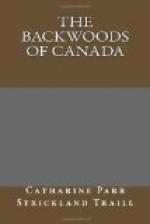=======================================
IV. TRANSFER OF CAPITAL.
It is, of course, of the greatest importance to emigrants that whatever capital they may possess, over the necessary expenses of the voyage, &c., should be remitted to Canada in the safest and most profitable manner. Both the British American Land Company and the Canada Company afford facilities to emigrants, by receiving deposits and granting letters of credit on their agents in Canada, by which the emigrants obtain the benefit of the current premium of exchange. It is unsafe and injudicious to carry out a larger amount of specie than what will defray the necessary expenses of the voyage, because a double risk is incurred,—the danger of losing, and the temptation of squandering. The emigrant, therefore, who does not choose to remit his money through either of the before-mentioned companies, should procure a letter of credit from some respectable bank in the United Kingdom on the Montreal bank.
=======================================
V. CANADIAN CURRENCY.
In all the British North American colonies accounts are kept and prices are quoted in pounds, shillings, and pence, as in England. The accounts are contra-distinguished by calling the former currency, or Halifax currency, and the latter sterling or British sterling.
The one pound Halifax currency, or currency, as it is more commonly called, consists of four Spanish dollars. The dollar is divided into five parts—called in Spanish pistoreens—each of which is termed a shilling. Each of these shillings or pistoreens is again subdivided into twelve parts, called pence, but improperly, for there is no coin answering to any such subdivision. To meet the want a great variety of copper coins are used, comprising the old English halfpenny, the halfpenny of later coinage, the penny, the farthing, the American cent.; all and each pass as the twenty-fourth part of the pistoreen or colonial shilling. Pence in fact are not known, though almost anything of the copper kind will be taken as the twenty-fourth part of the pistoreen.*
[* The Americans also have their 1 shilling, which is the eighth part of a dollar, or 12-1/2 cents. It is no uncommon thing to hear the emigrant boast that he can get 10 shillings per day in New York. He knows not that a dollar, which is equal to eight of these shillings, is in England equivalent but to 4 shillings 2 pence, and that the American shilling is, therefore, when compared with the English shilling in value, only 6-1/4 pence, and consequently, that 10 shillings a day is, in fact, but ten 6-1/4 pence or 5 shillings 2-1/2 pence. This rate of payment it may be said is still great; so it is, but it is not often obtained by the labourer; when it is, it is for excessive labour, under a burning sun in sea-port towns, during the busy shipping season.]




